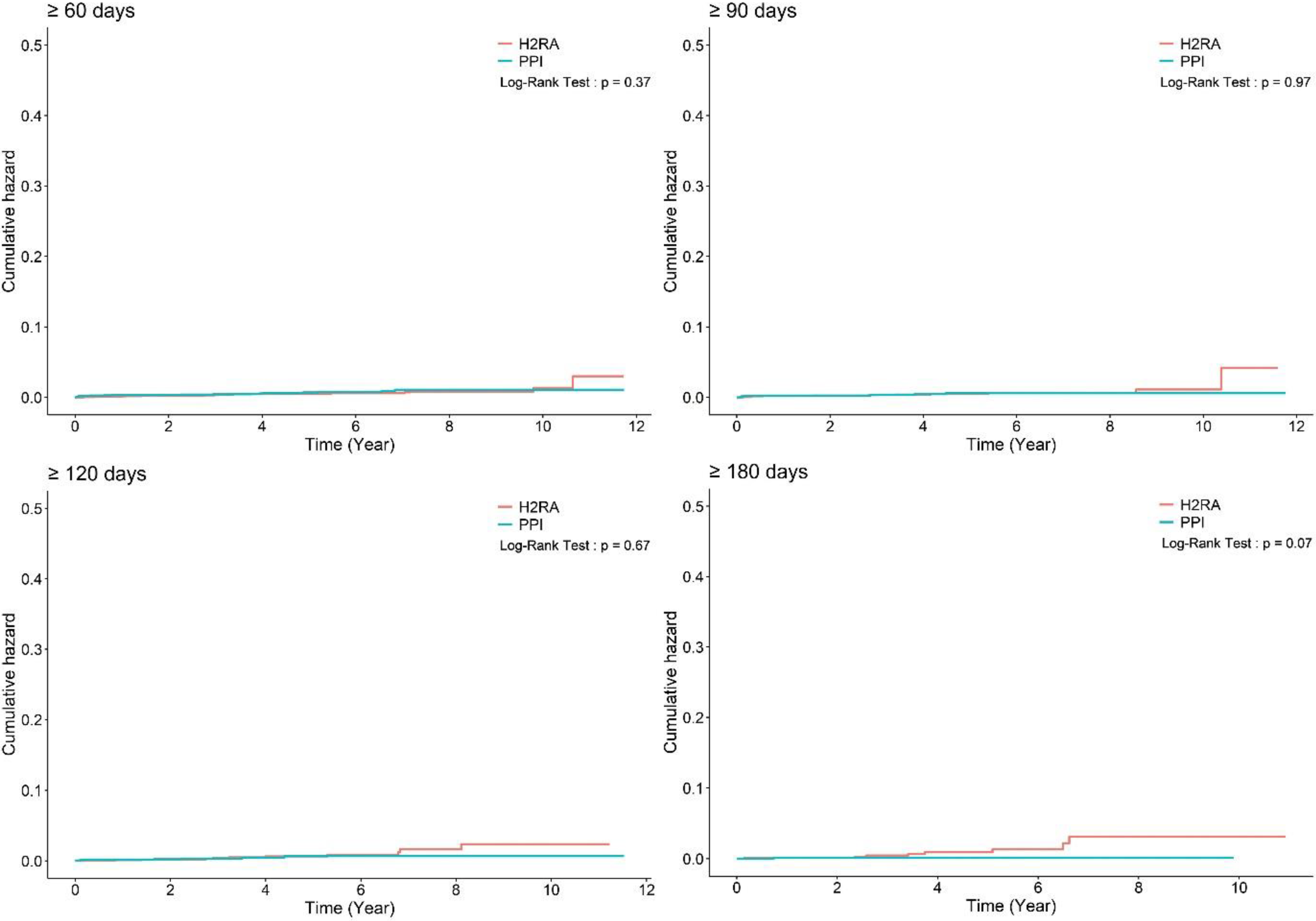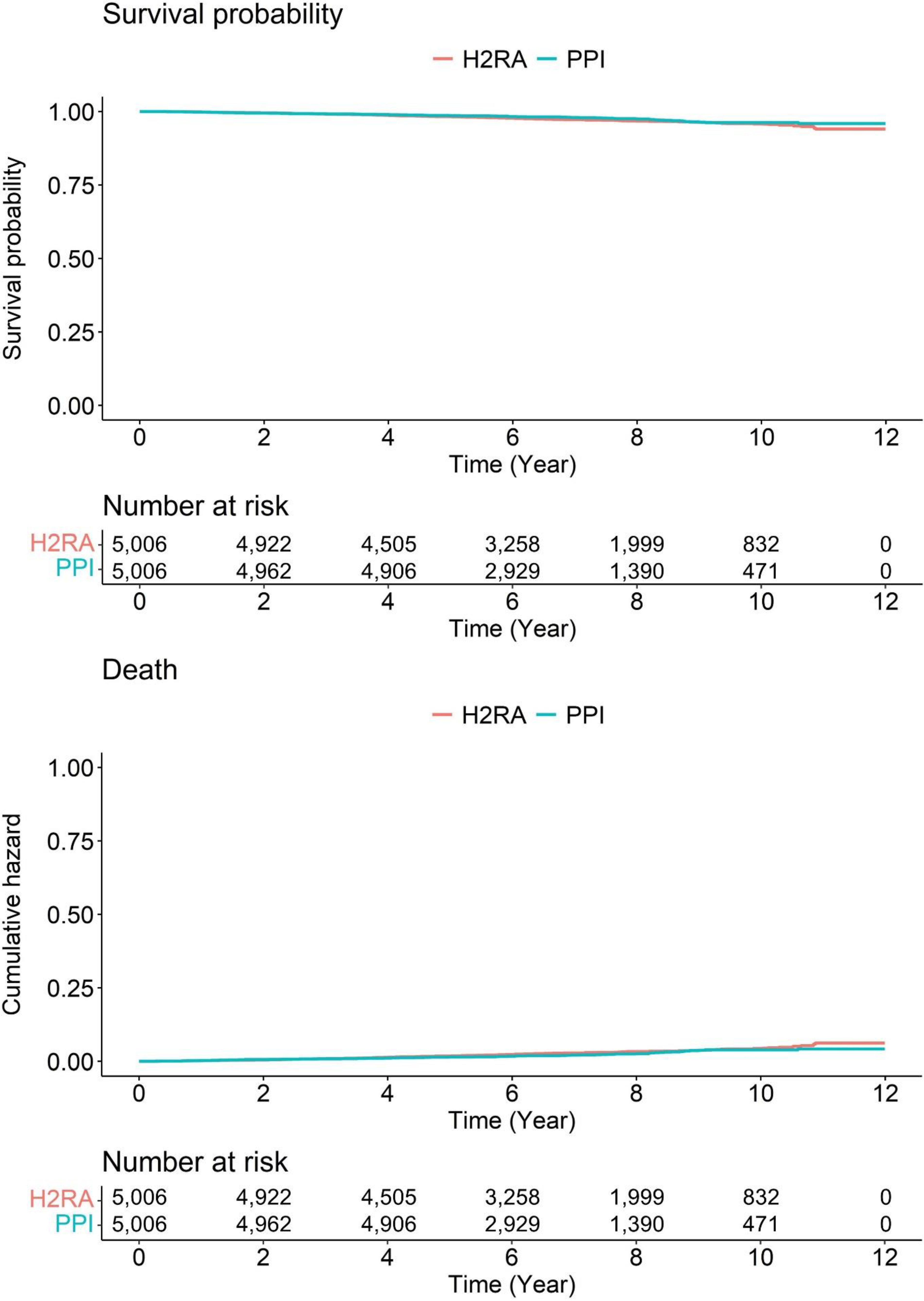Use of Proton Pump Inhibitors and the Risk for the Development of Gastric Cancers: A Nationwide Population-Based Cohort Study Using Balanced Operational Definitions
Abstract
Simple Summary
Abstract
1. Introduction
2. Methods
2.1. Source of Data
2.2. Research Design
2.3. Statistical Analysis
3. Results
3.1. Study Subjects
3.2. Gastric Cancer Development
3.3. Sensitivity/Subgroup Analysis and Mortality
4. Discussion
5. Conclusions
Supplementary Materials
Author Contributions
Funding
Institutional Review Board Statement
Informed Consent Statement
Data Availability Statement
Conflicts of Interest
References
- Sung, H.; Ferlay, J.; Siegel, R.L.; Laversanne, M.; Soerjomataram, I.; Jemal, A.; Bray, F. Global Cancer Statistics 2020: GLOBOCAN Estimates of Incidence and Mortality Worldwide for 36 Cancers in 185 Countries. CA Cancer J. Clin. 2021, 71, 209–249. [Google Scholar] [CrossRef] [PubMed]
- Bang, C.S.; Lee, J.J.; Baik, G.H. Computer-aided diagnosis of esophageal cancer and neoplasms in endoscopic images: A systematic review and meta-analysis of diagnostic test accuracy. Gastrointest. Endosc. 2021, 93, 1006–1015.e13. [Google Scholar] [CrossRef] [PubMed]
- Chen, Y.R.; Wang, M.Q.; Li, Y.T.; Li, P.; Ouyang, S.S.; Xu, H.W.; Zhu, S.L. Prognostic performance of different lymph node classification systems in young gastric cancer. J. Gastrointest. Oncol. 2021, 12, 1285–1300. [Google Scholar] [CrossRef] [PubMed]
- Balakrishnan, M.; George, R.; Sharma, A.; Graham, D.Y. Changing Trends in Stomach Cancer Throughout the World. Curr. Gastroenterol. Rep. 2017, 19, 36. [Google Scholar] [CrossRef] [PubMed]
- Arnold, M.; Park, J.Y.; Camargo, M.C.; Lunet, N.; Forman, D.; Soerjomataram, I. Is gastric cancer becoming a rare disease? A global assessment of predicted incidence trends to 2035. Gut 2020, 69, 823–829. [Google Scholar] [CrossRef] [PubMed]
- Heer, E.V.; Harper, A.S.; Sung, H. Emerging cancer incidence trends in Canada: The growing burden of young adult cancers. Cancer 2020, 126, 4553–4562. [Google Scholar] [CrossRef] [PubMed]
- Yamamoto, Y.; Fujisaki, J.; Omae, M.; Hirasawa, T.; Igarashi, M. Helicobacter pylori-negative gastric cancer: Characteristics and endoscopic findings. Dig. Endosc. 2015, 27, 551–561. [Google Scholar] [CrossRef] [PubMed]
- Freedberg, D.E.; Kim, L.S.; Yang, Y.X. The Risks and Benefits of Long-term Use of Proton Pump Inhibitors: Expert Review and Best Practice Advice from the American Gastroenterological Association. Gastroenterology 2017, 152, 706–715. [Google Scholar] [CrossRef] [PubMed]
- Shin, G.Y.; Park, J.M.; Hong, J.; Cho, Y.K.; Yim, H.W.; Choi, M.G. Use of Proton Pump Inhibitors vs. Histamine 2 Receptor Antagonists for the Risk of Gastric Cancer: Population-Based Cohort Study. Am. J. Gastroenterol. 2021, 116, 1211–1219. [Google Scholar] [CrossRef] [PubMed]
- Seo, S.I.; Park, C.H.; You, S.C.; Kim, J.Y.; Lee, K.J.; Kim, J.; Kim, Y.; Yoo, J.J.; Seo, W.W.; Lee, H.S.; et al. Association between proton pump inhibitor use and gastric cancer: A population-based cohort study using two different types of nationwide databases in Korea. Gut 2021, 70, 2066–2075. [Google Scholar] [CrossRef] [PubMed]
- Lee, J.; Lee, J.S.; Park, S.H.; Shin, S.A.; Kim, K. Cohort Profile: The National Health Insurance Service-National Sample Cohort (NHIS-NSC), South Korea. Int. J. Epidemiol. 2017, 46, e15. [Google Scholar] [CrossRef] [PubMed]
- Lee, S.Y. Changes in gastric microbiota during gastric carcinogenesis. Korean J. Helicobacter Up. Gastrointest. Res. 2018, 18, 95–102. [Google Scholar] [CrossRef]
- Brusselaers, N.; Wahlin, K.; Engstrand, L.; Lagergren, J. Maintenance therapy with proton pump inhibitors and risk of gastric cancer: A nationwide population-based cohort study in Sweden. BMJ Open 2017, 7, e017739. [Google Scholar] [CrossRef] [PubMed]
- Tran-Duy, A.; Spaetgens, B.; Hoes, A.W.; de Wit, N.J.; Stehouwer, C.D. Use of proton pump inhibitors and risks of fundic gland polyps and gastric cancer: Systematic review and meta-analysis. Clin. Gastroenterol. Hepatol. 2016, 14, 1706–1719.e5. [Google Scholar] [CrossRef] [PubMed]
- Ahn, J.S.; Eom, C.S.; Jeon, C.Y.; Park, S.M. Acid suppressive drugs and gastric cancer: A meta-analysis of observational studies. World J. Gastroenterol. 2013, 19, 2560–2568. [Google Scholar] [CrossRef] [PubMed]
- Anjiki, H.; Mukaisho, K.I.; Kadomoto, Y.; Yoshikawa, K.; Nakayama, T.; Vo, D.T.N.; Hattori, T.; Sugihara, H. Adenocarcinoma arising in multiple hyperplastic polyps in a patient with Helicobacter pylori infection and hypergastrinemia during long-term proton pump inhibitor therapy. Clin. J. Gastroenterol. 2017, 10, 128–136. [Google Scholar] [CrossRef] [PubMed]
- Jianu, C.S.; Fossmark, R.; Viset, T.; Qvigstad, G.; Sørdal, Ø.; Mårvik, R.; Waldum, H.L. Gastric carcinoids after long-term use of a proton pump inhibitor. Aliment. Pharmacol. Ther. 2012, 36, 644–649. [Google Scholar] [CrossRef] [PubMed]
- McCarthy, D.M. Proton Pump Inhibitor Use, Hypergastrinemia, and Gastric Carcinoids-What Is the Relationship? Int. J. Mol. Sci. 2020, 21, 662. [Google Scholar] [CrossRef] [PubMed]
- Bang, C.S.; Baik, G.H. Acid Secretory Inhibitors and the Risk of Development of Gastric Cancer. Korean J. Helicobacter Up. Gastrointest. Res. 2019, 19, 73–75. [Google Scholar] [CrossRef]
- Lee, J.K.; Merchant, S.A.; Schneider, J.L.; Jensen, C.D.; Fireman, B.H.; Quesenberry, C.P.; Corley, D.A. Proton Pump Inhibitor Use and Risk of Gastric, Colorectal, Liver, and Pancreatic Cancers in a Community-Based Population. Am. J. Gastroenterol. 2020, 115, 706–715. [Google Scholar] [CrossRef]



| Parameters | Current Study | Seo SI et al. [10] | Shin G-Y et al. [9] |
|---|---|---|---|
| Claim database used in each study | Korean NHIS-NSC (2002–2013) | 1. Korean NHIS-NSC (2002–2013) (OMOP-CDM version): for general population 2. Korean NHIS-NSC (2002–2013): for patients with H. pylori eradication | Korean NHIS (2002–2017) |
| Study subjects | PPI use for more than 60 days (only patients with H. pylori eradication) | PPI use for more than 30 consecutive days (matched and adjusted for H. pylori infection and patients with H. pylori eradication were separately analyzed) | PPI use for more than 180 days (matched and adjusted for H. pylori infection) |
| Possibility of the co-prescription in the study subjects | Study subjects are composed of never user of H2RA (pure PPI users) | Co-prescription or alternative prescription of PPIs with short-term H2RA cannot be excluded | Co-prescription or alternative prescription of PPIs with short-term H2RA cannot be excluded |
| Index date | Cumulative defined daily dose of at least 60 days (The first day of PPI prescription and the last day of H. pylori eradication was separately analyzed) | The first day of PPI prescription (The first day of H. pylori eradication was separately analyzed) | Cumulative defined daily dose of at least 180 days |
| Control subjects | Pure H2RA users | Subject taking any drug except PPI (Non-PPI or H2RA user was separately analyzed) | H2RA user |
| Definition of H. pylori eradication group | Who have been prescribed clarithromycin-based triple therapy or bismuth-based quadruple therapy for 7–14 days | Who have been prescribed clarithromycin-based triple therapy or bismuth-based quadruple therapy for 7–14 days | Concomitant prescription a PPI, clarithromycin, or metronidazole with amoxicillin or tetracycline |
| Age standard | ≥20 years | ≥20 years | ≥40 years |
| Exclusion criteria to avoid protopathic bias | Prescriptions of PPIs started within 6 months before gastric cancer were excluded | Prescriptions of PPIs started within 12 months before gastric cancer were excluded | Prescriptions of PPIs started within 6 months or EGD within 1 year before gastric cancer were excluded |
| Censoring | 1. Identification of gastric cancer or end of observation period 2. All cause death (separately analyzed) | Identification of gastric cancer or end of observation period (No mortality data) | Identification of gastric cancer or end of observation period or death (from a non-gastric cancer cause or gastric surgery) (No mortality data) |
| Duration of follow-up period | 6.56 years (IQR: 5.05–8.16 for PPI group, 5.15–9.21 for H2RA group) | Median 4.3 years (4.4 years in the PPI group and 4.2 years in the non-PPI group) | Median 4.2 years (IQR: 2.0–6.9) in the PPI group and 4.0 years (IQR: 1.85–6.81) years in the H2RA group |
| Study Subjects | N | Case | Incidence | Unadjusted HR (95% CI) | Adjusted HR (95% CI) | p-Value |
|---|---|---|---|---|---|---|
| (For more than) 60 days | ||||||
| H2RA | 5006 | 23 | 1.13 | 1.00 (ref) | 1.00 (ref) | |
| PPI | 5006 | 28 | 1.43 | 1.29 (0.74–2.24) | 1.30 (0.75–2.27) | 0.348 |
| 90 days | ||||||
| H2RA | 2919 | 13 | 1.16 | 1.00 (ref) | 1.00 (ref) | |
| PPI | 2919 | 11 | 1.12 | 0.98 (0.44–2.22) | 0.98 (0.43–2.22) | 0.961 |
| 120 days | ||||||
| H2RA | 1883 | 11 | 1.64 | 1.00 (ref) | 1.00 (ref) | |
| PPI | 1883 | 7 | 1.21 | 0.81 (0.31–2.12) | 0.81 (0.31–2.14) | 0.677 |
| 180 days | ||||||
| H2RA | 1003 | 8 | 2.34 | 1.00 (ref) | 1.00 (ref) | |
| PPI | 1003 | 1 | 0.37 | 0.18 (0.02–1.45) | 0.19 (0.02–1.53) | 0.119 |
Publisher’s Note: MDPI stays neutral with regard to jurisdictional claims in published maps and institutional affiliations. |
© 2022 by the authors. Licensee MDPI, Basel, Switzerland. This article is an open access article distributed under the terms and conditions of the Creative Commons Attribution (CC BY) license (https://creativecommons.org/licenses/by/4.0/).
Share and Cite
Gong, E.J.; Bang, C.S.; Kim, D.-K.; Lee, J.J.; Baik, G.H. Use of Proton Pump Inhibitors and the Risk for the Development of Gastric Cancers: A Nationwide Population-Based Cohort Study Using Balanced Operational Definitions. Cancers 2022, 14, 5172. https://doi.org/10.3390/cancers14205172
Gong EJ, Bang CS, Kim D-K, Lee JJ, Baik GH. Use of Proton Pump Inhibitors and the Risk for the Development of Gastric Cancers: A Nationwide Population-Based Cohort Study Using Balanced Operational Definitions. Cancers. 2022; 14(20):5172. https://doi.org/10.3390/cancers14205172
Chicago/Turabian StyleGong, Eun Jeong, Chang Seok Bang, Dong-Kyu Kim, Jae Jun Lee, and Gwang Ho Baik. 2022. "Use of Proton Pump Inhibitors and the Risk for the Development of Gastric Cancers: A Nationwide Population-Based Cohort Study Using Balanced Operational Definitions" Cancers 14, no. 20: 5172. https://doi.org/10.3390/cancers14205172
APA StyleGong, E. J., Bang, C. S., Kim, D.-K., Lee, J. J., & Baik, G. H. (2022). Use of Proton Pump Inhibitors and the Risk for the Development of Gastric Cancers: A Nationwide Population-Based Cohort Study Using Balanced Operational Definitions. Cancers, 14(20), 5172. https://doi.org/10.3390/cancers14205172







